#absurdist fantasy
Text

Simply and succinctly put, Nanny. No lie is detected.
#sir terry pratchett#discworld#the witches#maskerade#book quotes#nanny ogg#absurdist fantasy#books#books & libraries#books and reading#books and novels
64 notes
·
View notes
Text

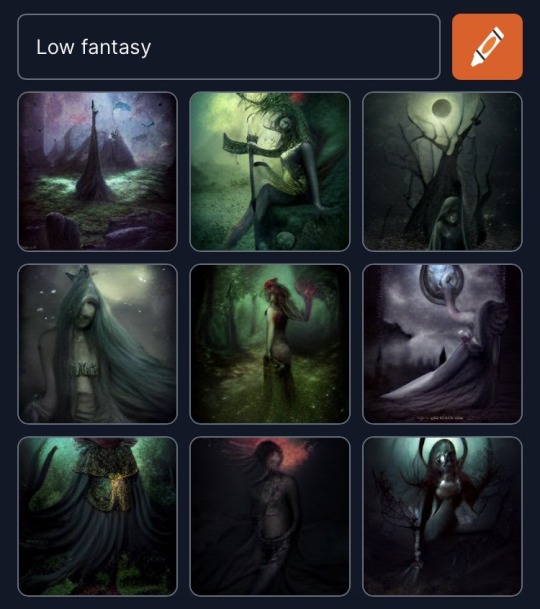





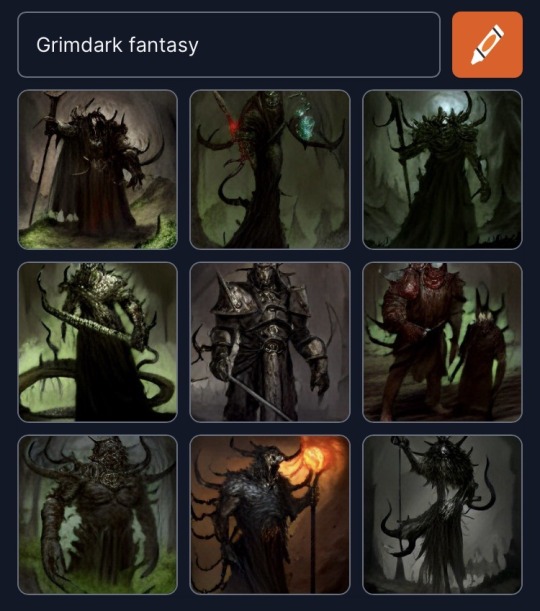


Craiyon + Fantasy subgenres
#unreality#craiyon#ai#ai art#fantasy#high fantasy#low fantasy#urban fantasy#historical fantasy#arthurian fantasy#absurdist fantasy#dark fantasy#grimdark fantasy#fairytale#magical realism#genre#genres
34 notes
·
View notes
Text
Sometimes a family can be a cranky boxing vampire with Rayman limbs, a ninja skunk voiced by SpongeBob SquarePants, a magnetic cyclops robot, an octopus pirate, a gorilla that digs, a chicken that shoots lightning from his eyes, some….fuzzy thing that surfs on a turbine—
#skylanders#you have no idea how much I love this franchise’s sensibilities#more of this please#i like when furries and robots and wizards mingle#absurdist kitchen sink fantasy type beat
24 notes
·
View notes
Text
Also I keep thinking about Saltburn and it's making me so mad
#it could have been so good and it just wasn't#the way that it was meant to be a Clever Absurdist's fantasy come true and the way that was absolutely not executed well#Bottoms did a way better job at executing an absurdist storyline in a believable way#saltburn was trying to be too much and ultimately lacks substance#and the character motivation!!! where was it??!!#cannot reconcile why Oliver was the way he was#being a weirdo is not enough to justify being a serial killer lmfaoo
23 notes
·
View notes
Text

#artists on tumblr#ai artwork#dark fantasy#“There's Someone Here to See You”#absurdist art#surreal horror
11 notes
·
View notes
Text
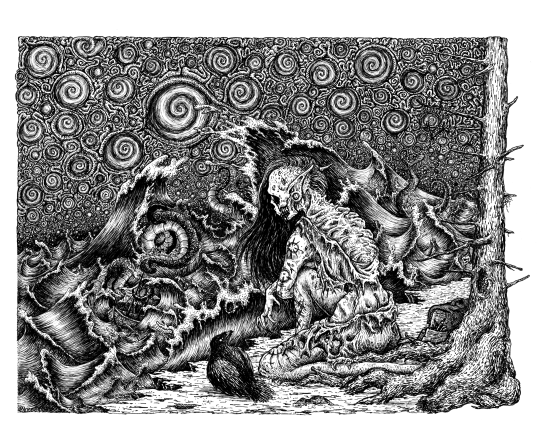
Following the pandemonium.
#art#darkart#dark fantasy art#lovecraftian art#nihilism art#absurdist art#fineliner art#surreal art#dark illustration#junji ito inspired#doom metal
43 notes
·
View notes
Text

For millennia, the sun has scared, confused, and mercilessly killed mankind just for the thrill. It abandons us during winter and abuses us come summer. And due to a seemingly endless, wholly passive-aggressive silent treatment, its reasoning for all this will likely remain a mystery for years to come.
But one mystery is finally solved.
A lack of orifices long left us unable to properly take the sun's temperature, leaving scientists to simply guess. But a collaboration between Apple and Frito-Lay saw the first manned mission to the sun in a heroic search for answers.
Unfortunately for 12-year old Daniel Lamb, from One Toilet, Indiana, and winner of the Doritos "Fun in the Sun Sweepstakes," this was a one-way trip.
"I just wanted a PlayStation," said Daniel in his final message, crying like a little baby.
As any parent who ever left their child in the car during a grueling heatwave so as to pop in for a quick root canal or colonoscopy might already know, children are often too stupid to turn on the A/C or crack a window.
But stupid children aside, there's also the matter of fuel.
"Have you seen how poor an iPhone's battery life is?" said Penny Pincher, Apple's V.P. of Tax Evasion. "And don't even get me started on the excessive cost of bundling our ship with a charging cable."
But while the incineration of a young child left his family mildly upset, scientists now know the sun is, at the very least, hot enough to do the same to aluminum and glass.
#scifi#fantasy#horror#writing#writing community#bizarro#bizarro fiction#gonzo#gonzo fiction#humor#humorist#absurd#absurdist#short story#shortstory#short fiction#comedy#creative writing#weird#weirdfiction#weird fiction#pulp fiction#lgbt#lgbt community#lgbt creator#nature#environment#sun#space#outer space
4 notes
·
View notes
Video
youtube
HOUSE OF THE UNHOLY
How much of the budget should be allocated to production design and costumes? A resounding YES was Daniel Merlot’s answer. Highly impressive visuals on all levels, as everything that Merlot and his team could think of is on screen. Part fever dream, part music video, and part absurdist fantasy, do yourself a favor and watch this highly entertaining journey into creativity.
#house of the unholy#Daniel Merlot#short#short film#fantasy#fantasy short#scifi#scifi short#science fiction#horror#horror short#everything everywhere all at once#genre#absurdist#fever dream#junkyard demento#dust
14 notes
·
View notes
Text
a lot of people seem really happy with the last episode (i think probably because of what they interpret it to mean for guillermo x nandor? but i’m not seeing it as that much of a development for them?) so maybe i’m in the minority here but it’s not just one thing or one episode or even one season, it’s like consistent gradual tone shifts toward humor that doesn’t appeal to me and writing choices that i find uninteresting and character development that feels counterintuitive to how i saw the characters and i feel like the current fanbase that has stuck with the series for all 5 seasons represents a totally different viewing experience than the one i’m having and probably enjoy the show for different reasons and are now understandably the target audience and i just am not. however i also just feel like the writing is not very good
#and like. i don’t want the show to be More Serious. i just want it to be a dark comedy#which it originally was. it’s more absurdist humor/sitcom humor/parody of fantasy media (instead of satire of vampire media. smh)#and there’s nothing wrong with that tbh its just. not what it was originally#it’s fine for a show to evolve i just don’t like it lol
4 notes
·
View notes
Text
Live on Kindle Vella, and free to read.
First chapter on my homebrew Urban Fantasy story.
It's first person, and the narrator is Ruth Graff, an asexual Jewish vampire who lives for justice, but maybe goes about it in the wrong way sometimes.
If you like vampires, the supernatural, Yiddish culture, and weighty discussions of ethics, you'll enjoy this.
0 notes
Text
Something Something Phangirl Meets Discworld
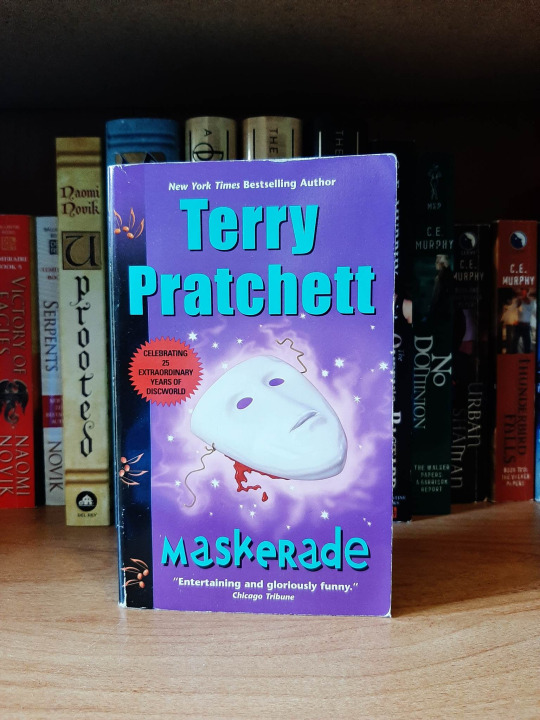
Back when I was an undergrad, I had procrastinated a couple of first-year core classes (required stuff that has jack shit to do with your major but is supposed to make you a "well-rounded student" for everyone who wasn't educated in the US) to the point where we were at the beginning of year four, we took a couple over the summer, but now we're staring down having to take Art Appreciation for an entire final term and I did not WANT to. So instead I took a two-week intensive "Wintermester" art appreciation course in a classroom whose carpets squished in Fairbanks, Alaska in December. The fact that it didn't become a horror movie is a miracle. BUT. YOU GUYS. This class introduced me to The Phantom of the Opera at the Royal Albert Hall, and thanks to how awesome that was, I finally went out and got the one Witches novel I hadn't bothered with at that point. Let's talk Maskerade.
Maskerade might be the Discworld book with which I've had the most dynamic relationship because I am currently what I would consider a "fallen" or "lapsed" theatre kid. However, when I picked up Maskerade for the first time, I was a "desperately trying to hold on to theatre with both hands and both feet despite ongoing and worsening health issues and a school theatre that has nearly succeeded in killing me three separate times but I don't want to let go" theatre kid. So on first read, I loved Agnes, I loved Nanny and Granny, Greebo is never not a standout, and I was fully over here like, "YES, THEATRE IS THE MIRACLE OF A THOUSAND THINGS FAILING TO GO WRONG!" I wasn't a huge fan of how Christine was characterized, and frankly I found the art/business dichotomy irksome.
I was barely 22 and an idiot. I have since grown some.
On subsequent reads in and beyond graduate school, I can see the love behind the pointed critiques, and I had run into the odd Christine or two, so I was far more willing to sympathize with Agnes--the single point of sensibility and practicality in a flamboyantly dramatical cats system that is often toxic. And while I liked the Nanny, Granny, and Enrico Basilica subplot on initial reads, now it is perhaps my entirely favorite part of the book. Adding the managed chaos that is the Witches to a theatre is amazing, and we get some really fantastic insights into how Nanny and Granny can leverage witchcraft beyond Lancre. It has a different flavor in Ankh Morpork, and what that ends up meaning for Walter Plinge is literally the difference between life and death.
The loving parodic use of theatrical tropes and traditions is honestly delightful throughout. I realize that saying, "Hey, so Sir Terry Pratchett was kind of amazing" on the internet is the oldest of old news, but honestly it bears repeating because Discworld is incredible.
Nanny Ogg's cookbook manages to be both hilarious and a scathing indictment of how poorly authors are paid--something that honestly just keeps gettting MORE relevant. I also love the low-key Producers-eqsue mixed with Shakespearean twinning aspects of having Nanny be the writer and Granny the accountant foiling off of Salzella and Bucket. Like, had their positions been reversed, the Ankh Morpork Opera House would have been flush with cash practically overnight and the cookbook would have ended up scammed. It's a really lovely, subtle little peice of foiling that 1000% was not required to make this book great, but I love that it's there.
So theatre kid phangirl me wasn't the biggest fan of this book, but grown-ass adult me with a little more life on her claims this as one of her top five all-time favorite Discworld books. I'm going to leave it here and realtively spoiler-free for those of you who might be on the fence about picking up the book. I highly recommend that you do, but I also recommend watching The Phantom of the Opera (either the Royal Albert Hall one or an actual stage production; don't START with the movie) before reading Maskerade, just to fully get the levels of allusion, parody, and homage.
#terry pratchett#sir terry pratchett#discworld#maskerade#the witches#granny weatherwax#nanny ogg#agnes nitt#phantom of the opera#absurdist fantasy#books & libraries#books and reading#books and novels#books#book recommendations
26 notes
·
View notes
Text
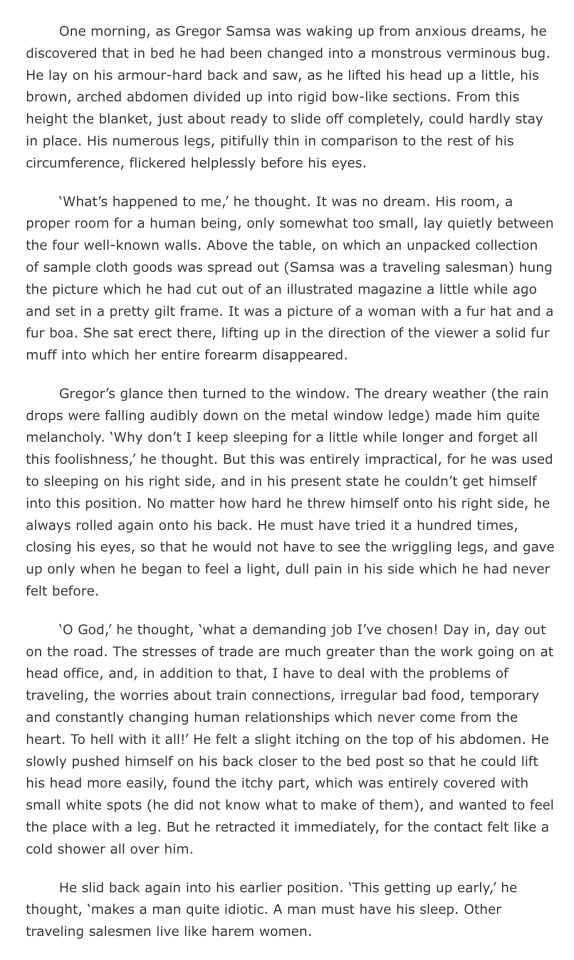
Franz Kafka, The Metamorphosis
#literature#classic literature#novella#absurdist fiction#fantasy fiction#The Metamorphosis#Franz Kafka
1 note
·
View note
Text
idk what possessed me, but I'm writing a synopsis for an absurdist fantasy. I plan to post the synopsis on here while I write the novella over the course of May. Like a self-imposed nanowrimo. It's got a hold of me and I can't let this story go like I have others.
There will be glitter.
1 note
·
View note
Text

15 notes
·
View notes
Text



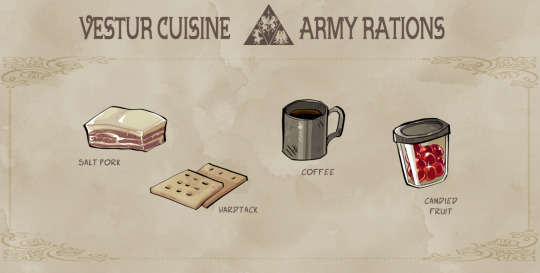
Foods of Vestur
@broncoburro and @chocodile provoked me into doing some illustrated worldbuilding for Forever Gold ( @forevergoldgame ), an endeavor I was happy to undertake. Unbeknownst to me, it would take the better part of a week to draw.
In the process, I conjured about an essay's worth of fantasy food worldbuilding, but I'm going to try and keep things digestible (pardon my pun). Lore under the cut:
The Middle Kingdom
The Middle Kingdom has ample land, and its soil, landscapes, and temperate climate are amenable to growing a variety of crops and raising large quantities of livestock. The Midland palate prefers fresh ingredients with minimal seasoning; if a dish requires a strong taste, a cook is more likely to reach for a sharp cheese than they are to open their spice drawer. Detractors of Middle Kingdom cuisine describe it as bland, but its flavor relies on the quality of its components more than anything.
KEY CROPS: wheat, potatoes, carrots, green beans, apples, pears, and grapes
KEY LIVESTOCK: Midland goats, fowl, and hogs
ROAST FOWL: Cheap and easy to raise, fowl is eaten all over Vestur and by all classes. Roasted whole birds are common throughout, but the Middle Kingdom's approach to preparation is notable for their squeamish insistence on removing the head and neck before roasting, even among poorer families. Fowl is usually roasted on a bed of root vegetables and shallots and served alongside gravy and green beans.
GOAT RIBEYE: Vestur does not have cattle – instead it has a widely diversified array of goats, the most prominent being the Middle Kingdom's own Midland goat. The Midland goat is a huge caprid that fills the same niche as cattle, supplying Vestur with meat and dairy products. Chevon from the Midland goat is tender with a texture much like beef, though it retains a gamier, “goat-ier” taste. It is largely eaten by the wealthy, though the tougher and cheaper cuts can be found in the kitchens of the working class. Either way, it is almost always served with gravy. (You may be sensing a pattern already here. Midlanders love their gravy.)
FETTUCCINE WITH CHEESE: Noodles were brought to the Middle Kingdom through trade with the South and gained popularity as a novel alternative to bread. The pasta of Midland Vestur is largely eaten with butter or cream sauce; tomato or pesto sauces are seldom seen.
CHARCUTERIE WITH WINE: Charcuterie is eaten for the joy of flavors rather than to satiate hunger, and therefore it is mainly eaten by the upper class. It is commonly eaten alongside grape wine, a prestigious alcohol uniquely produced by the Middle Kingdom. The flavor of grape wine is said to be more agreeable than the other wines in Vestur, though Southern pineapple wine has its share of defenders.
BREAD WITH JAM AND PRESERVES, TEA SANDWICHES, & ROSETTE CAKE: Breads and pastries are big in the Middle Kingdom. The Middle Kingdom considers itself the world leader in the art of baking. Compared to its neighbors, the baked goods they make are soft, light, and airy and they are proud of it. Cakes in particular are a point of ego and a minor source of mania among nobility; it is a well-established cultural joke that a Middle Kingdom noble cannot suffer his neighbor serving a bigger, taller cake. The cakes at Middle Kingdom parties can reach nauseatingly wasteful and absurdist heights, and there is no sign of this trend relenting any time soon.
CHOWDER, FARMER'S POT PIE, GRIDDLECAKES, EGGS, CURED MEATS: If you have the means to eat at all in the Middle Kingdom, you are probably eating well. Due to the Midland's agricultural strength, even peasant dishes are dense and filling. Eggs and cured meats are abundant, cheaper, and more shelf stable than fresh cuts and provide reprieve from the unending wheat and dairy in the Midland diet.
STEWED APPLES AND PEARS, JAM AND PRESERVES: The Midland grows a number of different fruits, with apples and pears being the most plentiful. In a good year, there will be more fruit than anyone knows what to do with, and so jams and preserves are widely available. Stewed fruit has also gained popularity, especially since trade with the Southern Kingdom ensures a stable supply of sugar and cinnamon.
NORTHERN KINGDOM - SETTLED
The Northern Kingdom is a harsh and unforgiving land. Historically, its peoples lived a nomadic life, but since the unification of the Tri-Kingdom more and more of the Northern population have opted to live a settled life. The “settled North” leads a hard life trying to make agriculture work on the tundra, but it is possible with the help of green meur. The Northern palate leans heavily on preserved and fermented foods as well as the heat from the native tundra peppers. Outsiders often have a hard time stomaching the salt, tang, and spice of Northern cuisine and it is widely considered “scary.”
KEY CROPS: potatoes, beets, carrots, tundra pepper
KEY LIVESTOCK: wooly goats, hares*
GOAT POT ROAST: Life up north is hard work and there is much to be done in a day. Thus, slow cooked one-pot meals that simmer throughout the day are quite common.
VENISON WITH PICKLES: Game meat appears in Northern dishes about as much as farmed meat – or sometimes even more, depending on the location. Even “classier” Northern dishes will sometimes choose game meat over domesticated, as is the case with the beloved venison with pickles. Cuts of brined venison are spread over a bed of butter-fried potato slices and potent, spicy pickled peppers and onions. The potatoes are meant to cut some of the saltiness of the dish, but... most foreigners just say it tastes like salt, vinegar, and burning.
MINER STEW: While outsiders often have a hard time distinguishing miner stew from the multitude of beet-tinged stews and pot roasts, the taste difference is unmistakable. Miner's stew is a poverty meal consisting of pickles and salt pork and whatever else is might be edible and available. The end result is a sad bowl of scraps that tastes like salt and reeks of vinegar. The popular myth is that the dish got its name because the Northern poor began putting actual rocks in it to fill out the meal, which... probably never happened, but facts aren't going to stop people from repeating punchy myths.
RYE TOAST WITH ONION JAM: Rye is hardier than wheat, and so rye bread is the most common variety in the North. Compared to Midland bread, Northern bread is dense and gritty. It is less likely to be enjoyed on its own than Midland bread, both because of its composition and because there's less to put on it. Unless you've the money to import fruit spreads from further south, you're stuck with Northern jams such as onion or pepper jam. Both have their appreciators, but bear little resemblance to the fruit and berry preserves available elsewhere in Vestur.
HARE DAIRY: Eating hare meat is prohibited in polite society due to its association with the haretouched and heretical nomadic folk religions, but hare dairy is fair game. Hare cheese ranges from black to plum in color, is strangely odorless, and has a pungent flavor akin to a strong blue cheese. It is the least contentious of hare milk products. Hare milk, on the other hand, is mildly toxic. If one is not acclimated to hare milk, drinking it will likely make them “milk sick” and induce vomiting. It is rarely drunk raw, and is instead fermented into an alcoholic drink similar to kumis.
MAPLE HARES AND NOMAD CANDY: Maple syrup is essentially the only local sweetener available in the North, and so it is the primary flavor of every Northern dessert. Simple maple candies are the most common type of sweet, though candied tundra peppers – known as “nomad candy” – is quite popular as well. (Despite its name, nomad candy is an invention of the settled North and was never made by nomads.)
TUNSUKH: Tunsukh is one of the few traditions from the nomadic era still widely (and openly) practiced among Northern nobility. It is a ceremonial dinner meant as a test of strength and endurance between political leaders: a brutally spiced multi-course meal, with each course being more painful than the last. Whoever finishes the dinner with a stoic, tear-streaked face triumphs; anyone who cries out in pain or reaches for a glass of milk admits defeat. “Dessert” consists of a bowl of plain, boiled potatoes. After the onslaught of tunsukh, it is sweeter than any cake.
NORTHERN KINGDOM – NOMADIC NORTH
Although the Old Ways are in decline, the nomadic clans still live in the far North beyond any land worth settling. They travel on hareback across the frozen wasteland seeking “meur fonts” - paradoxical bursts of meur that erupt from the ice and provide momentary reprieve from the harsh environment. The taste of nomad food is not well documented.
KEY CROPS: N/A
KEY LIVESTOCK: hares
PEMMICAN: Nomadic life offers few guarantees. With its caloric density and functionally indefinite “shelf life,” pemmican is about as close as one can get.
SEAL, MOOSE: Meat comprises the vast majority of the nomadic diet and is eaten a variety of ways. Depending on the clan, season, and availability of meur fonts, meat may be cooked, smoked, turned to jerky, or eaten raw. Moose and seal are the most common sources of meat, but each comes with its own challenges. Moose are massive, violent creatures and dangerous to take down even with the aid of hares; seals are slippery to hunt and only live along the coasts.
WANDER FOOD, WANDER STEW: When a green meur font appears, a lush jungle springs forth around it. The heat from red meur fonts may melt ice and create opportunities for fishing where there weren't before. Any food obtained from a font is known as “wander food.” Wander food is both familiar and alien; the nomads have lived by fonts long enough to know what is edible and what is not, but they may not know the common names or preparation methods for the food they find. Fish is simple enough to cook, but produce is less predictable. Meur fonts are temporary, and it's not guaranteed that you'll ever find the same produce twice - there is little room to experiment and learn. As a result, a lot of wander food is simply thrown into a pot and boiled into “wander stew,” an indescribable dish which is different each time.
CENVAVESH: When a haretouched person dies, their hare is gripped with the insatiable compulsion to eat its former companion... therefore, it is only proper to return the favor. Barring injury or illness, a bonded hare will almost always outlive its bonded human, and so the death of one's hare is considered a great tragedy among nomads. The haretouched – and anyone they may invite to join them – sits beside the head of their hare as they consume as much of its rib and organ meat as they can. Meanwhile, the rest of the clan processes the remainder of the hare's carcass so that none of it goes to waste. It is a somber affair that is treated with the same gravity as the passing of a human. Cenvavesh is outlawed as a pagan practice in the settled North.
HARE WINE: While fermented hare's milk is already alcoholic, further fermentation turns it into a vivid hallucinogen. This “hare wine” is used in a number of nomad rituals, most notably during coming of age ceremonies. Allegedly, it bestows its drinker with a hare's intuition and keen sense of direction... of course, truth is difficult to distinguish from fiction when it comes to the Old Ways.
SOUTHERN KINGDOM
The Southern Kingdom is mainly comprised of coast, wetland, and ever-shrinking jungle. While the land is mostly unfit for large-scale agriculture, seafood is plentiful and the hot climate is perfect for exorbitant niche crops. What they can't grow, they obtain easily through trade. Southerners have a reputation for eating anything, as well as stealing dishes from other cultures and “ruining” them with their own interpretations.
KEY CROPS: plantains, sweet potato, pineapple, mango, guava, sugarcane
KEY LIVESTOCK: fowl, marsh hogs, seals
GLAZED EEL WITH FRIED PLANTAINS: A very common configuration for Southern food is a glazed meat paired with a fried vegetable. It almost doesn't matter which meat and which vegetable it is – they love their fried food and they love their sweet and salty sauces in the South. Eel is a culturally beloved meat, much to the shock and confusion of visiting Midlanders.
NARWHAL STEW: Narwhal stew is the South's “anything goes” stew. It does not actually contain narwhal meat, as they are extinct (though the upper class may include dolphin meat as a protein) – instead, the name comes from its traditional status as a “forever soup,” as narwhals are associated with the passage of time in Southern culture. Even in the present day, Southern monasteries tend massive, ever-boiling pots of perpetual stew in order to feed the monks and sybils who live there. Narwhal stew has a clear kelp-based broth and usually contains shellfish. Beyond that, its ingredients are extremely varied. Noodles are a popular but recent addition.
FORAGE: The dish known as “forage” is likewise not foraged, or at least, it hasn't been forage-based in a good hundred years at least. Forage is a lot like poke; it's a little bit of everything thrown into a bowl. Common ingredients include fish (raw or cooked), seaweed, fried noodles, marinated egg, and small quantities of fruit.
HOT POT: Hot pot is extremely popular, across class barriers, in both the South proper and its enclave territories. This is due to its extreme flexibility - if it can be cooked in a vat of boiling broth, it will be. Crustaceans and shellfish are common choices for hot pot in the proper South, along with squid, octopus, mushrooms, and greens.
FLATBREAD: The Southern Kingdom doesn't do much baking. The vast majority of breads are fried, unleavened flatbreads, which are usually eaten alongside soups or as wraps. Wraps come in both savory and sweet varieties; savory wraps are usually stuffed with shredded pork and greens while sweet wraps – which are much more expensive – are filled with fruit and seal cheese.
GRILLED SKEWERS, ROAST SWEET POTATO: While a novel concept for Midlanders and Northerners, street food has long been a part of Southern Kingdom culture. You would be hard pressed to find a Southern market that didn't have at least three vendors pushing grilled or fried something or other. Skewers are the most common and come in countless configurations, but roast sweet potatoes are a close second.
CUT FRUIT AND SEAL CHEESE: Fresh fruit is popular in the South, both local and imported. While delicious on its own, Southerners famously pair it with seal cheese. Which leads me to an important topic of discussion I don't have room for anywhere else...
THE SOUTH AND CHEESE: Since the South doesn't have much in the way of dairy farming, cheese is somewhat rare in their cuisine – but it is present. And important. Cheese is the domain of the Church. Common goat dairy imported from the Middle Kingdom is turned to cheese by monks in Southern monasteries and sold to the Southern public, yes, but as you have noticed there is another cheese prominent in the Southern Kingdom diet: seal cheese. Seal cheese is unlike anything else that has ever been called cheese; the closest it can be compared to is mascarpone. It is is a soft, creamy cheese with a mild flavor and an indulgent fat content. It is used almost exclusively as a dessert, though it is only ever mildly sweetened if at all. It is extremely costly and held in high regard; the most religious Southerners regard it as holy. Dairy seals are a very rare animal and raised exclusively in a small number of Cetolist-Cerostian monasteries, where they are tended and milked by the monks. Due to their status as a holy animal, eating seal meat is forbidden. Eating their cheese and rendering their tallow into soap is fine though.
(HEARTLAND SOUTH) SOUTH-STYLE GOAT: The Heartland South is a Southern enclave territory in the Middle Kingdom. Visiting Midland dignitaries oft wrongly assume that because the Heartland South is in Middle Kingdom territory, Heartland Southerners eat the same food they do exactly as they do. They are horrified to find that familiar sounding dishes like “goat with potatoes” are completely and utterly unrecognizable, drenched in unfamiliar sauces and spices and served alongside fruit they've never eaten. Meanwhile, Heartland Southerners firmly believe that they have fixed the Middle Kingdom's boring food.
(BOREAL SOUTH) “TUNSUKH”: If Midlanders are afraid of Heartland Southern food, Northerners are absolutely furious about cuisine from the Boreal South - the most legendarily offensive being the Boreal South's idea of “tunsukh.” Southerners are no stranger to spice, so when Southern traders began interacting with the North, they liked tunsukh! It's just... they thought it needed a little Southern help to become a real meal, you know? A side of seal cheese soothed the burn and made the meal enjoyable. And because the meal was enjoyable, the portion sizes increased. And plain boiled potatoes? Well, those are a little too plain – creamy mashed sweet potato feels like more of a dessert, doesn't it? ...For some reason, Northerners didn't agree, but that's okay. The Boreal South knows they're just embarrassed they didn't think of pairing seal cheese with tunsukh sooner.
ARMY RATIONS
The food eaten by the King's Army is about what you would expect for late 1700s military; salt pork or salt chevon, hard tack, and coffee. The biggest divergence they have is also one of Vestur's biggest points of pride: they have the means to supply their troops with frivolous luxuries like small tins of candied fruit from the Midland. A love of candied fruit is essentially a Vesturian military proto-meme; proof that they serve the greatest Tri-Kingdom on the planet. Don't get between a military man and his candied fruit unless you want a fight.
#verse: forever gold#worldbuilding#fantasy worldbuilding#food worldbuilding#fantasy food#food art#animal death//#might have to proofread this later forgive any typos I am tired
530 notes
·
View notes
Text

For decades, scientists have warned us of the dire consequences of man's inexplicable war on nature: the oceans continue to warm; wildfires overstay their welcome even when you tell them you have work in the morning; and organic life slowly replaced by plastic doppelgangers.
But no study could have foreseen crocodiles spreading conspiracy theories across the internet.
Due to the increased presence of alcohol and fentanyl in the waters in which they live and in the people that they eat, the once fiercely independent crocodiles of Florida are now voting Republican, pistol whipping children at playgrounds, and posting videos to social media in which they claim President Biden is using the postal service to "trans" Americans with gay anthrax.
And while it may be easy to dismiss this as harmless fun by a species not only lacking opposable thumbs, but also the right to vote, researchers aren't convinced.
"As ancient apex predators, crocodiles know better than to attack with reckless abandon," said crocodologist Dr. Allison Gaydor. "They bide their time, luring in unsuspecting prey with talking points about personal liberties, free markets, and small government before striking with a flurry of clips from the Joe Rogan Experience."
And so far, this slower, methodical strategy by crocodiles is working where the "howling, rabid baboons flinging feces at everyone" strategy of modern right-wing grifters is failing. Watching just one video in which a crocodile debates the need for women and minority representation in film and television quickly results in algorithms suggesting similar videos on false flags operations by the PTA, schools providing students with litter boxes, and something about trees causing socialism.
"I can only hope the sea reclaims Florida before it's too late," said Dr. Gaydor.
#scifi#fantasy#horror#writing#writing community#bizarro#bizarro fiction#gonzo#gonzo fiction#humor#humorist#absurd#absurdist#short story#shortstory#short fiction#comedy#creative writing#weird#weirdfiction#weird fiction#pulp fiction#lgbt#lgbt community#lgbt creator#nature#animals#environment#florida#republicans
3 notes
·
View notes